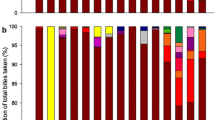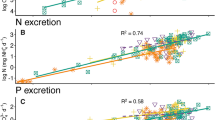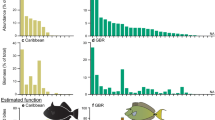Abstract
The recent loss of key consumers to exploitation and habitat degradation has significantly altered community dynamics and ecosystem function across many ecosystems worldwide. Predicting the impacts of consumer losses requires knowing the level of functional diversity that exists within a consumer assemblage. In this study, we document functional diversity among nine species of parrotfishes on Caribbean coral reefs. Parrotfishes are key herbivores that facilitate the maintenance and recovery of coral-dominated reefs by controlling algae and provisioning space for the recruitment of corals. We observed large functional differences among two genera of parrotfishes that were driven by differences in diet. Fishes in the genus Scarus targeted filamentous algal turf assemblages, crustose coralline algae, and endolithic algae and avoided macroalgae, while fishes in the genus Sparisoma preferentially targeted macroalgae. However, species with similar diets were dissimilar in other attributes, including the habitats they frequented, the types of substrate they fed from, and the spatial scale at which they foraged. These differences indicate that species that appear to be functionally redundant when looking at diet alone exhibit high levels of complementarity when we consider multiple functional traits. By identifying key functional differences among parrotfishes, we provide critical information needed to manage parrotfishes to enhance the resilience of coral-dominated reefs and reverse phase shifts on algal-dominated reefs throughout the wider Caribbean. Further, our study provides a framework for predicting the impacts of consumer losses in other species rich ecosystems.






Similar content being viewed by others

References
Adam TC, Schmitt RJ, Holbrook SJ et al (2011) Herbivory, connectivity, and ecosystem resilience: response of a coral reef to a large-scale perturbation. PLoS One 6:e23717. doi:10.1371/journal.pone.0023717
Adam TC, Burkepile DE, Ruttenberg BI, Paddack MJ (2015a) Herbivory and the resilience of Caribbean coral reefs: knowledge gaps and implications for management. Mar Ecol Prog Ser 520:1–20. doi:10.3354/meps11170
Adam TC, Kelley M, Ruttenberg BI, Burkepile DE (2015) Abundance and behavior of parrotfishes (Labridae, Scarinae) in the upper Florida Keys from 2013-06-19 to 2013-07-30 (NODC Accession 0127525)
Adler PB, Raff DA, Lauenroth WK (2001) The effect of grazing on the spatial heterogeneity of vegetation. Oecologia 128:465–479. doi:10.1007/s004420100737
Alvarez-Filip L, Côté IM, Gill JA et al (2011) Region-wide temporal and spatial variation in Caribbean reef architecture: is coral cover the whole story? Glob Chang Biol 17:2470–2477. doi:10.1111/j.1365-2486.2010.02385.x
Anderson MJ (2001) A new method for non-parametric multivariate analysis of variance. Austral Ecol 26:32–46
Bakker J, de Leeuw J, van Wieren S (1984) Micro-patterns in grassland vegetation created and sustained by sheep-grazing. Plant Ecol 55:153–161
Bellwood DR, Fulton CJ (2008) Sediment-mediated suppression of herbivory on coral reefs: decreasing resilience to rising sea-levels and climate change? Limnol Oceanogr 53:2695–2701. doi:10.4319/lo.2008.53.6.2695
Bellwood DR, Hughes TP, Folke C, Nyström M (2004) Confronting the coral reef crisis. Nature 429:827–833. doi:10.1038/nature02691
Bellwood DR, Hughes TP, Hoey AS (2006) Sleeping functional group drives coral-reef recovery. Curr Biol 16:2434–2439. doi:10.1016/j.cub.2006.10.030
Birrell CL, McCook LJ, Willis BL (2005) Effects of algal turfs and sediment on coral settlement. Mar Pollut Bull 51:408–414. doi:10.1016/j.marpolbul.2004.10.022
Bohnsack JA, Harper DE (1988) Length-weight relationships of selected marine reef fishes from the southeastern United States and the Caribbean. NOAA technical memorandum NMFS-SEFC-215, pp 1–31
Bohnsack JA, Harper DE, Mcclellan DB (1994) Fisheries trends from Monroe County, Florida. Bull Mar Sci 54:982–1018
Bonaldo RM, Hoey AS, Bellwood DR (2014) The ecosystem roles of parrotfishes on tropical reefs. Oceanogr Mar Biol An Annu Rev 52:81–132
Bozec Y-M, Alvarez-Filip L, Mumby PJ (2015) The dynamics of architectural complexity on coral reefs under climate change. Glob Chang Biol 21:223–235. doi:10.1111/gcb.12698
Brandl SJ, Bellwood DR (2014) Individual-based analyses reveal limited functional overlap in a coral reef fish community. J Anim Ecol 83:661–670. doi:10.1111/1365-2656.12171
Bruggemann JH, Kuyper MWM, Breeman AM (1994) Comparative analysis of foraging and habitat use by the sympatric Caribbean parrotfish Scarus vetula and Sparisoma viride (Scaridae). Mar Ecol Prog Ser 112:51–66
Bruno JF, Sweatman H, Precht WF (2009) Assessing evidence of phase shifts from coral to macroalgal dominance on coral reefs. Ecology 90:1478–1484
Burkepile DE, Hay ME (2008) Herbivore species richness and feeding complementarity affect community structure and function on a coral reef. Proc Natl Acad Sci USA 105:16201–16206. doi:10.1073/pnas.0801946105
Burkepile DE, Hay ME (2010) Impact of herbivore identity on algal succession and coral growth on a Caribbean reef. PLoS One 5:e8963. doi:10.1371/journal.pone.0008963
Burkepile DE, Hay ME (2011) Feeding complementarity versus redundancy among herbivorous fishes on a Caribbean reef. Coral Reefs 30:351–362. doi:10.1007/s00338-011-0726-6
Cadotte MW, Carscadden K, Mirotchnick N (2011) Beyond species: functional diversity and the maintenance of ecological processes and services. J Appl Ecol 48:1079–1087. doi:10.1111/j.1365-2664.2011.02048.x
Cardoso SC, Soares MC, Oxenford HA, Côté IM (2009) Interspecific differences in foraging behaviour and functional role of Caribbean parrotfish. Mar Biodivers Rec 2:e148. doi:10.1017/S1755267209990662
Carpenter RC (1986) Partitioning herbivory and its effects on coral reef algal communities. Ecol Monogr 56:345–364
Chesson J (1983) The estimation and analysis of preference and its relatioship to foraging models. Ecology 64:1297–1304
De Knegt HJ, Groen TA, van de Vijver CADM et al (2008) Herbivores as architects of savannas: inducing and modifying spatial vegetation patterning. Oikos. doi:10.1111/j.2008.0030-1299.16403.x
Dirzo R, Young H, Galetti M, Ceballos G (2014) Defaunation in the Anthropocene. Science 345:401–406
Du Toit JT, Cumming DHM (1999) Functional significance of ungulate diversity in African savannas and the ecological implications of the spread of pastoralism. Biodivers Conserv 8:1643–1661
Duffy JE (2002) Biodiversity and ecosystem function: the consumer connection. Oikos 99:201–219. doi:10.1034/j.1600-0706.2002.990201.x
Edwards CB, Friedlander AM, Green AG et al (2014) Global assessment of the status of coral reef herbivorous fishes: evidence for fishing effects. Proc R Soc B Biol Sci 281:20131835. doi:10.1098/rspb.2013.1835
Estes JA, Terborgh J, Brashares JS et al (2011) Trophic downgrading of planet Earth. Science 333:301–306. doi:10.1126/science.1205106
Folke C, Carpenter S, Walker B (2004) Regime shifts, resilience, and biodiversity in ecosystem management. Annu Rev Ecol Evol Syst 35:557–581. doi:10.2307/annurev.ecolsys.35.021103.30000021
Hamilton SL, Smith JE, Price NN, Sandin SA (2014) Quantifying patterns of fish herbivory on Palmyra Atoll (USA), an uninhabited predator-dominated central Pacific coral reef. Mar Ecol Prog Ser 501:141–155. doi:10.3354/meps10684
Hawkins JP, Roberts CM (2003) Effects of fishing on sex-changing Caribbean parrotfishes. Biol Conserv 115:213–226. doi:10.1016/S0006-3207(03)00119-8
Hoey AS, Bellwood DR (2009) Limited functional redundancy in a high diversity system: single species dominates key ecological process on coral reefs. Ecosystems 12:1316–1328. doi:10.1007/s10021-009-9291-z
Hughes TP, Rodrigues MJ, Bellwood DR et al (2007) Phase shifts, herbivory, and the resilience of coral reefs to climate change. Curr Biol 17:360–365. doi:10.1016/j.cub.2006.12.049
Hughes TP, Graham NAJ, Jackson JBC et al (2010) Rising to the challenge of sustaining coral reef resilience. Trends Ecol Evol 25:633–642. doi:10.1016/j.tree.2010.07.011
Jackson J, Donovan M, Cramer K, Lam V (eds) (2014) Status and Trends of Caribbean Coral Reefs 1970–2012. Global Coral Reef Monitoring Network c/o International Union for the Conservation of Nature Global Marine and Polar Program, Washington, D. C
Legendre P, Legendre L (2012) Numerical ecology. Third English Edition. Elsevier, Amsterdam
Lewis SM (1985) Herbivory on coral reefs: algal susceptibility to herbivorous fishes. Oecologia 65:370–375
Lewis SM, Wainwright PC (1985) Herbivore abundance and grazing intensity on a Caribbean coral reef. J Exp Mar Bio Ecol 81:215–228
Lokrantz J, Nyström M, Thyresson M, Johansson C (2008) The non-linear relationship between body size and function in parrotfishes. Coral Reefs 27:967–974. doi:10.1007/s00338-008-0394-3
MacArthur R, Levins R (1967) The limiting similarity, convergence, and divergence of coexisting species. Am Nat 101:377–385
Maj A (2011) lmmfit: goodness-of-fit measures for linear mixed models with one-level-grouping. R package version 1.0
Mantyka CS, Bellwood DR (2007) Macroalgal grazing selectivity among herbivorous coral reef fishes. Mar Ecol Prog Ser 352:177–185. doi:10.3354/meps07055
McAfee ST, Morgan SG (1996) Resource use by five sympatric parrotfishes in the San Blas Archipelago, Panama. Mar Biol 125:427–437
McCauley DJ, Pinsky ML, Palumbi SR et al (2015) Marine defaunation: animal loss in the global ocean. Science 347:1255641. doi:10.1126/science.1255641
McClanahan TR, Bergman K, Huitric M et al (2000) Response of fishes to algae reduction on Glovers Reef, Belize. Mar Ecol Prog Ser 206:273–282. doi:10.3354/meps206273
McNaughton S (1984) Grazing lawns: animals in herds, plant form, and coevolution. Am Nat 124:863–886
Mumby PJ (2006) The impact of exploiting grazers (Scaridae) on the dynamics of Caribbean coral reefs. Ecol Appl 16:747–769
Nash KL, Graham N, Bellwood DR (2013) Fish foraging patterns, vulnerability to fishing and implications for the management of ecosystem function across scales. Ecol Appl 23:1632–1644
Oksanen J, Blanchet FG, Kindt R, Legendre P, Minchin PR, O’Hara RB, Simpson GL, Solymos P, Stevens MHH, Wagner H (2013) vegan: community ecology package. R package version 2.0–10
Paddack MJ, Cowen RK, Sponaugle S (2006) Grazing pressure of herbivorous coral reef fishes on low coral-cover reefs. Coral Reefs 25:461–472. doi:10.1007/s00338-006-0112-y
Perry CT, Murphy GN, Kench PS et al (2013) Caribbean-wide decline in carbonate production threatens coral reef growth. Nat Commun 4:1402. doi:10.1038/ncomms2409
Peterson G, Allen C, Holling C (1998) Ecological resilience, biodiversity, and scale. Ecosystems 1:6–18
Pinheiro J, Bates D, DebRoy S, Sarkar D; R Development Core Team (2013). nlme: linear and nonlinear mixed effects models. R package version 3.1-113
Randall JE (1967) Food habits of reef fishes of the West Indies. Stud Trop Oceanogr 5:665–847
Rasher DB, Hoey AS, Hay ME (2013) Consumer diversity interacts with prey defenses to drive ecosystem function. Ecology 94:1347–1358
Reinthal P, Lewis S (1986) Social behaviour, foraging efficiency and habitat utilization in a group of tropical herbivorous fish. Anim Behav 34:1687–1693
Robertson DR, Gaines SD (1986) Interference competition structures habitat use in a local assemblage of coral reef surgeonfishes. Ecology 67:1372–1383
Sandin SA, McNamara DE (2012) Spatial dynamics of benthic competition on coral reefs. Oecologia 168:1079–1090. doi:10.1007/s00442-011-2156-0
Seabloom E, Richards S (2003) Multiple stable equilibria in grasslands mediated by herbivore population dynamics and foraging behavior. Ecology 84:2891–2904
Steneck RS, Arnold SN, Mumby PJ (2014) Experiment mimics fishing on parrotfish: insights on coral reef recovery and alternative attractors. Mar Ecol Prog Ser 506:115–127. doi:10.3354/meps10764
Streelman JT, Alfaro M, Westneat MW (2002) Evolutionary history of the parrotfishes: biogeography, ecomorphology, and comparative diversity. Evolution (N Y) 56:961–971
Wilson SK, Bellwood DR, Choat JH, Furnas MJ (2003) Detritus in the epilithic algal matrix and its use by coral reef fishes. Oceanogr Mar Biol 41(41):279–309
Acknowledgments
This work was supported by a grant from the NOAA Coral Reef Conservation Program to BIR and DEB and facilitated by grant number OCE-1130786 from the National Science Foundation to DEB and R. Vega Thurber. We thank Laura Catano for assistance with fieldwork and Andrew Hoey and one anonymous reviewer for comments that improved the manuscript. This work was conducted with permission from the Florida Keys National Marine Sanctuary under permit no. FKNMS-2013-058. The authors have no conflicts of interest to declare.
Author contribution statement
TCA designed the study with input from DEB and BIR. TCA and MK conducted field work. TCA developed methodology and performed analyses. TCA and DEB wrote the manuscript; BIR provided editorial advice.
Author information
Authors and Affiliations
Corresponding author
Additional information
Communicated by Jeff Shima.
Electronic supplementary material
Below is the link to the electronic supplementary material.
Rights and permissions
About this article
Cite this article
Adam, T.C., Kelley, M., Ruttenberg, B.I. et al. Resource partitioning along multiple niche axes drives functional diversity in parrotfishes on Caribbean coral reefs. Oecologia 179, 1173–1185 (2015). https://doi.org/10.1007/s00442-015-3406-3
Received:
Accepted:
Published:
Issue Date:
DOI: https://doi.org/10.1007/s00442-015-3406-3



